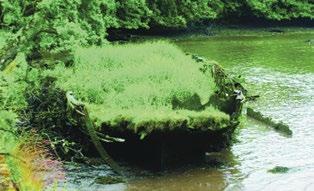
5 minute read
Forgotten Wrecks of the First World War
What do you think of when the First World War is mentioned? Most people will immediately think of the Somme and other notable land battles resulting in huge loss of life. Probably, comparatively few will immediately think of the maritime war and in particular the fundamental role played by the Mercantile Marine (today’s Merchant Navy). Roger Burns (Class of 1964)
The German U-boat wolf pack did not feature until the Second World War in which they sunk less ships than German submarines sank in the First World War and these maritime losses were substantial. Over 1,100 ships including some aeroplanes and airships were sunk during the First World War in the territorial waters along the south coast of England alone as depicted to the right. A four-year project, 2014–2018, has been undertaken by the Maritime Archaeological Trust. This has been generously funded by the Heritage Lottery Fund to research these wrecks, largely forgotten and deteriorating in the prevailing environment. The project, named Forgotten Wrecks of the First World War: Remembering and Commemorating through Archaeology, has involved not only the Trust’s staff but also a great many volunteers, of whom former pupil Roger Burns (Class of 1964) has been one for the final 18 months of the project. The results of which are available to the public on-line on the Maritime Archaeological Trust’s website. On 5 September 1914, HMS Pathfinder was the first Allied loss, off the Firth of Forth, from German U-boat action, and French torpedo boat Torpilleur 325 was the last near the toe of Italy on 22 January 1919. The tabulated 10 nations hardest hit by U-boat actions totalled 7,282 attacks inclusive of ships sunk, damaged and captured, covering all theatres of the First World War, with other nations totalling a further 380 attacks. Nearly 13m tons representing almost 5,000 allied ships and 15,000 lives were
British French Norwegian Italian Greek Danish Russian Swedish Dutch American Other 3,741 802 796 689 272 256 192 181 179 174 379
Hulk Kingswear Castle from the stern

A steel hulled passenger paddle steamer voyaging up and down the Dart between Dartmouth and Totnes. Built in 1904 it continued with a reduced service during the First World War. Taken out of service in 1924 with its engines reused in its successor, it was moored in Dartmouth harbour as a hospital isolation ship until 1927, then abandoned. Forward half of Hulk Winifred

A small wooden coastal trader completed in May 1897. Survived the First World War, used on the Falmouth balloon barrage in the Second World War, fitted with a small auxiliary motor servicing the other barrage vessels, with little known thereafter. Its trading voyages before and after the First World War were confined to English ports in the western English Channel.

SS Gallia – View of the three boilers with one lying on the seabed having rolled out of its mountings Becoming familiar with the methodology of wreck research, he
set against 202 German submarines and 5,000 lives lost. Very approximately, 25% of allied ship losses lie within the Forgotten Wrecks project as depicted in the map. Volunteers assisting the Trust have involved divers, field teams surveying intertidal sites, researchers, 3D model creators, an inhouse artist, booklet authors, and more. Roger’s role has been predominantly researching the history of nearly 200 wrecks online. However, with encouragement from the Trust’s staff, he has also researched and written several articles including the loss of Hallsands village and Wireless Telegraphy. Roger has also contributed to some of their world-wide ports of call for the wife of a relation who
of the Trust’s Intertidal and Archaeological reports. Intertidal wrecks are typified by two images from abandoned hulks on the River Dart in Devon (see previous page). Although there were many ships powered by sail still in use such as small fishing vessels and coastal trading schooners, the majority of ships of this period were powered by 3-cylinder triple expansion steam engines. One of the Trust’s archaeological Reports concerns SS Gallia: The loss of life associated with these wrecks is usually commemorated at one of the Commonwealth War Grave Memorials. The rule for inclusion on one of these memorials is that the loss of life must have been due to enemy action and it follows that the names of fatalities due to other circumstances, viewed on computers / laptops as opposed to mobile phones and
such as illness, collision, foundering without enemy action, and accidents unfortunately do not feature on these memorials although there are a few exceptions. Roger’s professional career was in civil engineering in the UK maritime or archaeological history, so joining the Trust to research maritime activities from the First World War was an unexpected venture which turned out to be fascinating and rewarding. discovered more detail about the SS Persia, which was lost to a German torpedo in the Mediterranean on 30 December 1915. A total of 343 passengers and crew of the P&O liner lost their lives including Roger’s retired paternal grandparents from Dundee who were returning to Calcutta to resume management of a jute mill to release younger incumbents for active service. Roger has also provided an inventory of ships served on and many knew little of the maritime history of her father’s merchant navy life as a “Marconi Operator” between 1915 and 1933. This, and the chance discovery that there was a Wireless College in Dundee providing training to become Wireless Telegraphists, created the “spark” for Roger to research maritime wireless telegraphy up until 1919 and write the article for the Forgotten Wrecks project mentioned above.
For further information and to view the work that the Maritime Archaeological Trust is undertaking, please visit their website: www.maritimearchaeologytrust.org To view the Trusts’ interactive 3D models on the Forgotten Wrecks please visit: www.maritimearchaeologytrust.org/hmd-johnmitchell-interactive-model. Please note that this video is best and abroad – he is a confirmed landlubber with no known family
tablets.


From the Dundee Evening Telegraph - Monday 30 November 1914










